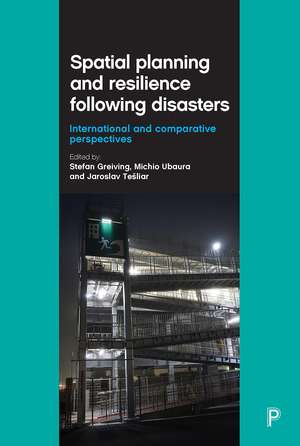Spatial Planning and Resilience Following Disasters: International and Comparative Perspectives
Editat de Stefan Greiving, Michio Ubaura, Jaroslav Tes¡liaren Limba Engleză Paperback – 5 dec 2017
Population shifts and an increase in the number of both natural and manmade disasters are having a profound effect on urban and rural habitats globally. Discussing for the first time the role of spatial planning after significant disasters, this book brings together the experiences and knowledge of international contributors from academia, research, policy, and practice to highlight ongoing efforts to improve spatial resilience across the globe and predict future trends. Comparisons of responses in five countries—the United States, Japan, Indonesia, Slovakia, and Germany—point to the varied influence of significant disasters on spatial planning and resiliency under different legal, administrative, and cultural frameworks, enabling contributors to draw conclusions about the transferability of approaches between different countries.
| Toate formatele și edițiile | Preț | Express |
|---|---|---|
| Paperback (1) | 399.35 lei 6-8 săpt. | |
| Bristol University Press – 5 dec 2017 | 399.35 lei 6-8 săpt. | |
| Hardback (1) | 837.13 lei 6-8 săpt. | |
| Bristol University Press – 28 iul 2016 | 837.13 lei 6-8 săpt. |
Preț: 399.35 lei
Nou
Puncte Express: 599
Preț estimativ în valută:
76.42€ • 79.99$ • 63.60£
76.42€ • 79.99$ • 63.60£
Carte tipărită la comandă
Livrare economică 29 martie-12 aprilie
Preluare comenzi: 021 569.72.76
Specificații
ISBN-13: 9781447323594
ISBN-10: 1447323599
Pagini: 352
Dimensiuni: 152 x 229 x 23 mm
Greutate: 0.54 kg
Editura: Bristol University Press
Colecția Policy Press
ISBN-10: 1447323599
Pagini: 352
Dimensiuni: 152 x 229 x 23 mm
Greutate: 0.54 kg
Editura: Bristol University Press
Colecția Policy Press
Notă biografică
Stefan Greiving is Executive Director of the Institute of Spatial Planning at TU Dortmund University. His main interests are in the areas of disaster risk management, adaptation to climate change and spatial planning. Michio Ubaura is Associate Professor in the Department of Architecture and Building Science at Tohoku University. His specialty is spatial planning. Jaroslav Tesliar is Director of the Agency for the Support of Regional Development Kosice, Slovakia. His interest is regional development in general with focus on climate change.
Cuprins
Introduction: Disaster response and spatial planning – key challenges and strategies ~ Stefan Greiving;
PART A;
I. Japan;
Disaster risk management and land use in Japan: In geography vulnerable to water-related disasters ~ Kanako Iuchi;
Spatial Planning Control for Housing Recovery after Great East Japan Earthquake ~ Tamiyo Kondo;
Reconstruction plans and planning processes after the Great East Japan Earthquake ~ Michio Ubaura;
II. Indonesia;
Land use politics after Indian Ocean Tsunami 2004 ~ Togu Pardede;
Coastal resilience in Indonesia: From plan to implementation ~ Surtiari, G.A.K ., Garschagen, M ., Birkmann , J., Setiadi, N ., Manuati, Y;
III. USA;
Planning for resilience in the New York metro region after Superstorm Sandy ~ Donovan Finn;
IV. Slovakia;
Spatial planning focusing on risk management in Slovakia ~ Alena Kučeravcová, Jan Dzurdženík;
Enhancement of flood management and flood-protection planning in Eastern Slovakia ~ Jozef Šuľak, Jaroslav Tešliar;
V. Germany;
Flood risk management by spatial planning ~ Stefan Greiving, Nadine Mägdefrau;
Major-accident hazards in spatial planning ~ Nadine Mägdefrau;
Cross-Analysis of Part A ~ Stefan Greiving, Nadine Mägdefrau, Teresa Sprague;
PART B;
Planning systems for risk reduction and issues in pre-disaster implementation ~ Kanako Iuchi;
Efforts and limitations in spatial transformation after disasters ~ Michio Ubaur;
Role of coordination in building spatial resilience after disasters ~ Alena Kučeravcová, Jozef Šuľak, Jaroslav Tešliar, Ján Dzurdženík;
Residents’ participation in rebuilding more resilient space ~ Nadine Mägdefrau, Teresa Sprague;
Spatial planning and uncertainties associated with future disasters ~ Stefan Greiving;
Conclusion: Change-proof cities and regions – an integrated concept for tackling key challenges for spatial development ~ Stefan Greiving, Kanako Iuchi, Jaroslav Tesliar, Michio Ubaura.
PART A;
I. Japan;
Disaster risk management and land use in Japan: In geography vulnerable to water-related disasters ~ Kanako Iuchi;
Spatial Planning Control for Housing Recovery after Great East Japan Earthquake ~ Tamiyo Kondo;
Reconstruction plans and planning processes after the Great East Japan Earthquake ~ Michio Ubaura;
II. Indonesia;
Land use politics after Indian Ocean Tsunami 2004 ~ Togu Pardede;
Coastal resilience in Indonesia: From plan to implementation ~ Surtiari, G.A.K ., Garschagen, M ., Birkmann , J., Setiadi, N ., Manuati, Y;
III. USA;
Planning for resilience in the New York metro region after Superstorm Sandy ~ Donovan Finn;
IV. Slovakia;
Spatial planning focusing on risk management in Slovakia ~ Alena Kučeravcová, Jan Dzurdženík;
Enhancement of flood management and flood-protection planning in Eastern Slovakia ~ Jozef Šuľak, Jaroslav Tešliar;
V. Germany;
Flood risk management by spatial planning ~ Stefan Greiving, Nadine Mägdefrau;
Major-accident hazards in spatial planning ~ Nadine Mägdefrau;
Cross-Analysis of Part A ~ Stefan Greiving, Nadine Mägdefrau, Teresa Sprague;
PART B;
Planning systems for risk reduction and issues in pre-disaster implementation ~ Kanako Iuchi;
Efforts and limitations in spatial transformation after disasters ~ Michio Ubaur;
Role of coordination in building spatial resilience after disasters ~ Alena Kučeravcová, Jozef Šuľak, Jaroslav Tešliar, Ján Dzurdženík;
Residents’ participation in rebuilding more resilient space ~ Nadine Mägdefrau, Teresa Sprague;
Spatial planning and uncertainties associated with future disasters ~ Stefan Greiving;
Conclusion: Change-proof cities and regions – an integrated concept for tackling key challenges for spatial development ~ Stefan Greiving, Kanako Iuchi, Jaroslav Tesliar, Michio Ubaura.
Recenzii
“In times of growing awareness on the crucial role of spatial planning in disaster recovery and resilience building, this book meets the challenge outstandingly by bringing together prominent contributors from academia, research, and policy making to judge remediation efforts after calamities with an indelible imprint on the human history.”





